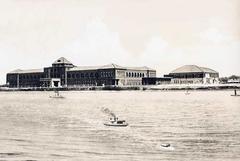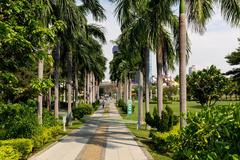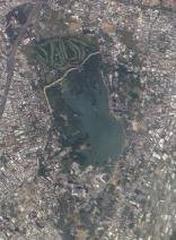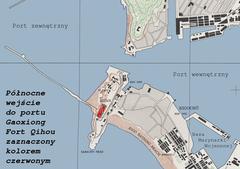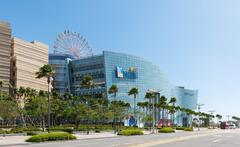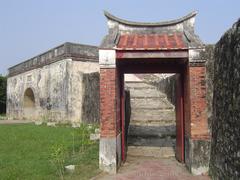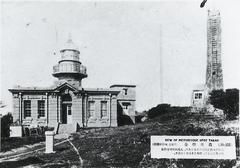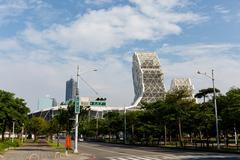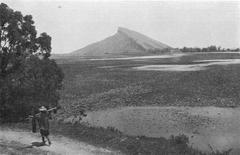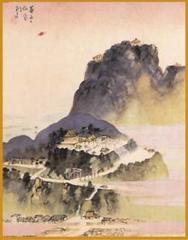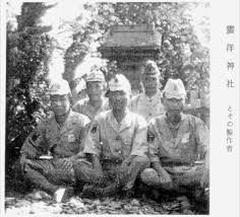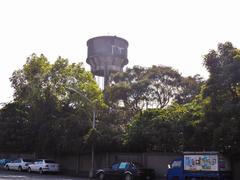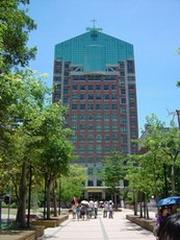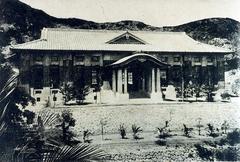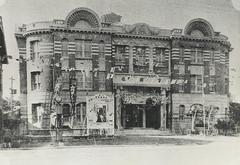Sizihwan Scenic Area Visiting Guide: Hours, Tickets, and Attractions
Publication Date: 18/07/2024
Why Visit Sizihwan Scenic Area
Today, Sizihwan Bay stands as a testament to the diverse cultural influences that have shaped Kaohsiung and Taiwan, offering visitors a unique blend of historical landmarks, religious sites, and natural wonders. This guide aims to provide detailed information on the top attractions, visiting hours, ticket prices, travel tips, and more, ensuring that your visit to Sizihwan Scenic Area is both memorable and enriching.
What You’ll Find in This Guide
- Introduction
- History and Cultural Significance of Sizihwan Bay
- Early Days and Indigenous Roots
- The Arrival of the Dutch and the Name “Sizihwan”
- Japanese Colonial Era and Industrial Development
- Post-War Period and Transformation into a Tourist Destination
- Practical Visitor Information
- Visiting Hours
- Ticket Prices
- Travel Tips
- Nearby Attractions
- Accessibility
- Top Attractions in Sizihwan Scenic Area
- British Consulate at Takao
- The Former Residence of British Consul
- Sizihwan Bay
- Sizihwan Lighthouse
- Chaishan Mountain (Shoushan)
- Martyrs’ Shrine of Kaohsiung City
- National Sun Yat-sen University
- Cijin Island
- Love Pier
- Kaohsiung Museum of History
- FAQ
- Conclusion
Explore Sizihwan Bay - Visiting Hours, Tickets, and Historical Significance
Introduction
Sizihwan Bay, with its breathtaking sunsets and historical landmarks, holds a special place in the heart of Kaohsiung. This article explores the bay’s rich history, cultural significance, practical visitor information, and why it remains an essential destination for anyone seeking to understand the heart and soul of Kaohsiung.
History and Cultural Significance of Sizihwan Bay
Early Days and Indigenous Roots
Long before its emergence as a popular tourist destination, Sizihwan Bay was inhabited by indigenous communities. Archaeological evidence suggests the presence of the Makakey tribe, who relied on the sea for sustenance and considered the area sacred. Their connection to the land and water is an integral part of the bay’s early history.
The Arrival of the Dutch and the Name “Sizihwan”
The bay’s modern history began to take shape in the 17th century with the arrival of the Dutch East India Company. Seeking to establish a trading outpost, the Dutch were drawn to the area’s strategic location and natural harbor. It was during this period that the name “Sizihwan” emerged, derived from the Hokkien term “Takau,” which referred to the bamboo forests that once flourished along the bay’s shores.
Japanese Colonial Era and Industrial Development
The dawn of the 20th century saw Taiwan come under Japanese rule, ushering in a new era for Sizihwan Bay. Recognizing the area’s potential, the Japanese embarked on ambitious development projects, transforming the bay into a significant industrial hub. Key industries like shipbuilding and sugar refining took root, forever altering the landscape and economic significance of Sizihwan. The remnants of this era, including old warehouses and factories, now stand as silent witnesses to the bay’s industrial past.
Post-War Period and Transformation into a Tourist Destination
Following World War II, Sizihwan Bay underwent a gradual transformation. With the decline of heavy industries, the focus shifted towards tourism and recreation. The bay’s natural beauty, coupled with its historical significance, made it an attractive destination for both domestic and international visitors.
Practical Visitor Information
Visiting Hours
Sizihwan Bay is accessible to visitors 24 hours a day, although specific attractions within the bay, such as museums and temples, have their own operating hours. It’s recommended to check the individual sites for the most current information.
Ticket Prices
While general access to Sizihwan Bay is free, some historical sites and museums may charge an entrance fee. For example, entry to the British Consulate at Takao museum typically costs around NT$99 for adults.
Travel Tips
- Getting There: Sizihwan Bay is easily accessible by public transportation. The Kaohsiung MRT’s Orange Line takes you to the Sizihwan Station, which is a short walk from the bay.
- Best Time to Visit: The best time to visit is during the late afternoon to enjoy the stunning sunset views.
- What to Bring: Comfortable walking shoes, a camera for capturing the scenic views, and sun protection are recommended.
Nearby Attractions
In addition to the historical sites within Sizihwan Bay, visitors can explore nearby attractions such as the Pier-2 Art Center, Cijin Island, and the scenic Love Pier.
Accessibility
Many areas around Sizihwan Bay are wheelchair accessible, although some historical buildings may have limited accessibility due to their age and structure.
Top Attractions in Sizihwan Scenic Area
British Consulate at Takao
Perched atop Shaochuantou, this red-brick Victorian-era building offers panoramic views of Sizihwan Bay. Built in 1865, it served as the British Consulate during the era of trade between Taiwan and the West. Today, it stands as a well-preserved historical site and museum, showcasing exhibits on the building’s history and Kaohsiung’s maritime past. Visitors can explore the consulate’s elegant rooms, admire the period furniture, and enjoy a cup of tea at the on-site teahouse while soaking in the breathtaking scenery.
- Visiting Hours: 9 AM - 5 PM
- Tickets: NT$50 for adults, free for children under 12
The Former Residence of British Consul
Located just below the British Consulate, this charming two-story building served as the residence of the British Consul. Constructed in 1879, it features a distinct architectural style blending Chinese and Western elements. Now a museum, it offers a glimpse into the lifestyle of British officials during their time in Taiwan. Visitors can wander through the well-preserved rooms, admire the antique furnishings, and learn about the daily life and social customs of the era.
- Visiting Hours: 9 AM - 5 PM
- Tickets: NT$30 for all visitors
Sizihwan Bay
The heart of the scenic area, Sizihwan Bay, captivates visitors with its crescent-shaped shoreline and sparkling blue waters. The bay offers stunning views, especially during sunset when the sky erupts in vibrant hues. Visitors can stroll along the seaside promenade, enjoying the refreshing sea breeze and picturesque scenery. The area is also popular for cycling, with bike rentals readily available.
- Visiting Hours: Open 24 hours
- Tickets: Free
Sizihwan Lighthouse
Standing tall on a hill overlooking the bay, Sizihwan Lighthouse is a prominent landmark and navigational beacon. Built in 1883, the octagonal-shaped tower features a distinctive black and white exterior. While the lighthouse itself is not open to the public, the surrounding area offers breathtaking views of the coastline, harbor, and city skyline. Visitors can enjoy a leisurely walk up to the lighthouse, taking in the panoramic vistas along the way.
- Visiting Hours: Open 24 hours
- Tickets: Free
Chaishan Mountain (Shoushan)
Forming a natural barrier to the north of Sizihwan, Chaishan Mountain, also known as Shoushan, offers a green escape from the city. Visitors can explore the mountain’s numerous hiking trails, ranging in difficulty from easy strolls to challenging climbs. The mountain is home to diverse flora and fauna, including monkeys, birds, and butterflies. At the summit, visitors are rewarded with panoramic views of Sizihwan, Kaohsiung City, and the Taiwan Strait.
- Visiting Hours: Open 24 hours
- Tickets: Free
Martyrs’ Shrine of Kaohsiung City
Located on the slopes of Shoushan, this shrine honors the soldiers who lost their lives in the Second Sino-Japanese War. The shrine’s grand architecture, with its sweeping roofs and intricate carvings, is a sight to behold. Visitors can pay their respects at the main hall, admire the surrounding gardens, and enjoy panoramic views of the city from the shrine’s elevated position.
- Visiting Hours: 8 AM - 5 PM
- Tickets: Free
National Sun Yat-sen University
Situated on the foothills of Shoushan, National Sun Yat-sen University (NSYSU) is a prestigious institution renowned for its beautiful campus. Visitors can stroll through the sprawling grounds, admiring the blend of modern and traditional architecture. The university’s seaside location adds to its charm, offering scenic views of Sizihwan Bay.
- Visiting Hours: Open 24 hours
- Tickets: Free
Cijin Island
A short ferry ride from Sizihwan, Cijin Island offers a different perspective on the area’s beauty. Visitors can explore the island’s sandy beaches, historic forts, and seafood restaurants. Cijin Lighthouse, Qihou Fort, and the Black Sand Beach are some of the island’s popular attractions.
- Visiting Hours: Open 24 hours
- Tickets: Free (Ferry ride - NT$25 for adults, NT$15 for children)
Love Pier
This pier, extending into Sizihwan Bay, has become a popular spot for couples and photographers. The pier’s romantic ambiance, especially during sunset, makes it an ideal location for a leisurely stroll or to capture memorable photos.
- Visiting Hours: Open 24 hours
- Tickets: Free
Kaohsiung Museum of History
Located near Sizihwan, this museum offers insights into the city’s rich history and cultural heritage. Exhibits showcase Kaohsiung’s transformation from a small fishing village to a major port city. Visitors can learn about the area’s maritime history, industrial development, and cultural evolution.
- Visiting Hours: 9 AM - 5 PM (Closed on Mondays)
- Tickets: NT$30 for adults, free for children under 12
Conclusion
Sizihwan Scenic Area is a must-visit destination in Kaohsiung, offering a blend of natural beauty and fascinating historical landmarks. Be sure to check the visiting hours and ticket prices in advance to make the most of your trip. Whether you’re exploring the British Consulate, hiking up Chaishan Mountain, or simply enjoying the sunset at Sizihwan Bay, this area promises a memorable experience.
FAQ
Q: What are the best times to visit Sizihwan Scenic Area?
A: The best times to visit are early morning or late afternoon to avoid the midday heat. Sunsets at Sizihwan Bay are particularly stunning.
Q: Are there any special events in Sizihwan?
A: Yes, Sizihwan often hosts cultural festivals and events, especially during the summer months. Check local listings for up-to-date information.
Q: What should I bring when visiting Sizihwan?
A: Comfortable walking shoes, sunscreen, a hat, and plenty of water are recommended. A camera is also a must to capture the beautiful scenery.
Q: Is Sizihwan Scenic Area accessible for people with disabilities?
A: While some areas may be challenging due to uneven terrain, many attractions are accessible. It is advisable to check specific accessibility options for each site.
Call to Action
For more updates and travel tips, download the Audiala mobile app, check out our other related posts, and follow us on social media.
